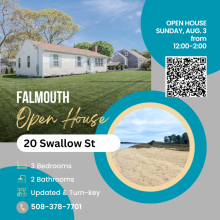Marion Master Plan encourages 'village style' development, senior housing
After three years of input from officials and residents, Marion's Master Plan for the next 10 years is complete, and encourages maintaining a "village style" for the town, promoting economic development on Route 6, and developing senior housing and services.
The Southeast Regional Planning and Economic Development District (SRPEDD) helped the town develop the plan, along with the Planning Board, a Master Plan subcommittee, and the public. Voters will be asked to accept the plan at Town Meeting in October.
“It’s a vision document, filled with ideas that people have about what they’d like Marion to be in the future,” explained Planning Board member Jen Francis, who presented the plan to the Selectmen on Tuesday. “It’s not what we’re going to do, it’s a collection of ideas that we could pursue.”
Covering a 10-year period, Master Plans address a community's goals for land use, housing, climate change, economic development, services and facilities, transportation, open space and recreation, and natural and cultural resources. Completing a Master Plan not only ensures that town officials work from a shared vision for the community, but also makes the town eligible for various state grants.
The main goal of the new Master Plan is to encourage “village style” development for the town, which was what residents chose as their preferred style of development during public meetings.
“Village style development” includes small site plans, moderate densities, diverse housing options and a variety of uses. Development designs indicate a village-style layout, with shops and services within walking distance and a variety of local shopping, entertainment and service options.
This type of development is currently allowed only in Marion’s General Business and Limited Business districts, which make up 2.2 percent of the town; however, the Master Plan suggests updating Marion’s zoning bylaws to allow “village style” development in what residents consider "acceptable" areas, such as Route 6 and Marion Village.
Marion’s older population was a considerable factor in creating the Master Plan. While the overall population has decreased by 4.2 percent from 2000, the median age of residents has shifted upward, from 36.4 in 2000 to 46.1 in 2010. The Master Plan encourages promoting “senior friendly” housing, which includes smaller units, year-round rental options and housing with supportive services.
The plan also suggests developing a Route 6 corridor plan to promote safety and business development. A focus on that corridor could bring multi-family housing or senior housing close to amenities, and allow business development in what was deemed by residents to be an acceptable development area.
The Master Plan also suggests creating a "Business Development Commission" to advise the Selectmen on business development strategies, and market the town's strength and character to potential businesses.
The plan encourages finding an immediate and cost-effective solution to Marion’s wastewater treatment plant problems, which it notes is delaying additional development.
The wastewater treatment plant, which is at capacity, has a moratorium on new sewer tie-ins, which presents a problem for developers looking to handle wastewater via the sewer system. Suggested solutions include lining the town's sewer lagoons, making improvements to the current plant, and studying a the possibility of creating a regionalized sewer service.
The plan also addresses climate change. Goals include better tracking of floods (in partnership with Tabor Academy), and work toward obtaining grants which would allow Marion to implement protection against storms and climate change effects.
"We felt it was very important aspect to Marion," Francis explained. "I’ve been approached about by other towns like Mattapoisett and Bourne—towns with the same sea coast vulnerabilities that we have."
Regional transportation is also considered in the Master Plan. It suggests collaboration with the Southeast Regional Transport Authority (SRTA) and the Greater Attleboro Taunton Regional Transit Authority (GATRA) to provide Marion with fixed-route, on-demand transportation. SRTA routes are currently available in Mattapoisett, while GATRA serves nearby Wareham. Benefits of working with a regional transit authority include financial and technical assistance to the Council on Aging.
Francis explained that two action committees have already been formed as a result of the Master Plan. One, the Stewards of Community Open Space, is a committee made up of representatives of various open space protection programs. The other, the Transportation and Circulation Task Force, looks at transportation and all related projects in town, particularly improving the safety and walkability of Route 6.
“We need to get more people involved with this,” Selectman Norm Hills said. Francis agreed.
“Hopefully now that we have a guiding document, it will be helpful in giving people ideas to rally around,” she said.
Public information sessions on the Master Plan will be held on September 18 at 7 p.m. and October 14 at 9 a.m., in the Sippican School Multi-Purpose Room. SRPEDD representative Grant King will be on-hand to answer questions.
The selectmen offered praise for those involved in developing the plan.
“You did a beautiful job with the Master Plan,” Selectman Jody Dickerson said. “It’s an outstanding job.”
Copies of the Master Plan are available at the Planning Board office, the Town Clerk’s office, the Elizabeth Taber Library, and the police station. Electronic copies can be downloaded at http://marionma.gov.
Questions or concerns should be sent to Town Planner Gil Hilario at ghilario@marionma.gov or 508-748-3513.














